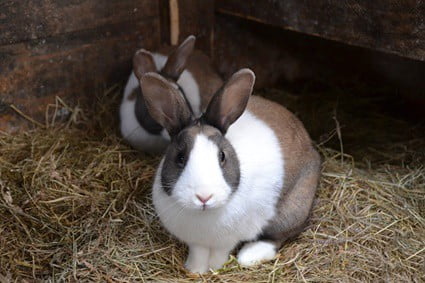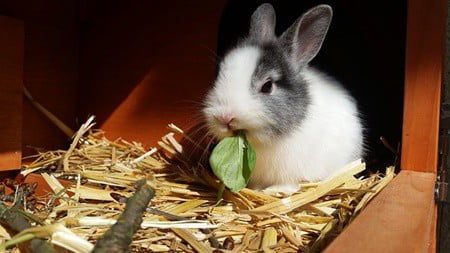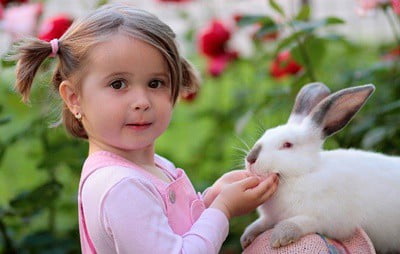Every trait a rabbit has, from its hearing to its instincts, has evolved in response to predators. This means that your rabbit may ignore you, hide in its cage, and respond cautiously to handling.
Getting a rabbit’s attention involves alerting it to your presence. As a prey animal, it will startle easily, and it can grow uneasy if constantly surprised. Rabbits have good vision and hearing, so using verbal and visual cues alert it to your presence and ensnares its attention.
Your rabbit may be ignoring you deliberately or unintentionally. So, a rabbit that is losing its sense of hearing or sight may not notice you. Alternatively, the rabbit may be ignoring you deliberately. This means it considers itself the dominant member of the household, is annoyed with you for some reason, or it thinks that you may be a predator.
How Do You Get A Bunny’s Attention?
Getting a rabbit’s attention can be tricky, especially for a new or young rabbit that isn’t comfortable in your home yet. The Dental Research Journal notes that rabbits evolved as prey animals.
This means their response to stimuli is very different to how your childhood cat or dog may have reacted to being called. A rabbit is more inclined to deliberately ignore your call until it feels safe in the home.
Visual Cues
Rabbits have very good eyesight. Nature states that a rabbit’s eyesight is primed for movement detection, and its visual range is almost 360 degrees.
The use of visual cues can be good for alerting a rabbit to your presence and teaching it non-verbal commands. Used in conjunction with verbal commands, visual cues can be useful for capturing a rabbit’s attention.
Visual cues don’t have to be commands either, such as those used for tricks. They can be ways to communicate with your rabbit in general. Rabbits, both domestic and wild, use body language to speak with one and other. You can use this to your advantage.

When approaching your rabbit, remain relaxed and calm. Use easy, predictable movements. This tells the rabbit that you are not a threat, whereas sharp or jerky movements can say something else entirely. The rabbit may interpret this as either:
- There is a threat that you have detected
- You are the threat and are preparing to pounce
Select three different visual commands and be consistent with them to engage your rabbit’s attention. Ensure that your rabbit can see you when you are trying to get its attention as well. This catches its eye and draws it to properly focus on you.
Food And Treats
Some pets will come running if they hear the crinkle of the treat package, and their attention will be rooted on any treats in your hands.
Treats are a pretty much guaranteed method of grabbing your rabbit’s attention. Be careful not to overdo it, though. You’ll run the risk of feeding the rabbit too many treats, causing an imbalanced diet and weight issues. There is also the chance of your rabbit learning that every interaction with you means receiving treats.
Using treats to get your rabbit’s attention is useful for training and rewarding good behavior. You can also use treats to bond with a new rabbit. Either way, be sure to use treats in moderation, or substitute vegetables or regular rabbit pellets as treats to prevent weight gain.
Verbal Commands
Verbal commands are vital for every pet owner, aside from those with deaf animals, including rabbits. Not only do verbal commands grab your rabbit’s attention, but they are an excellent means of communication.
A rabbit will learn to recognize its name. It will also learn to recognize the tone you use when saying its name. The ‘dinner’s ready’ tone, the ‘you’re in trouble’ tone, and the ‘come here’ tone all have their own cadences, and your rabbit will learn them.
Certain tones may grab your rabbit’s attention more than others. Test what tones your rabbit responds to most and make adjustments where needed. Also, consider if you are being too loud, too grumpy, too soft, or too high-pitched. While a louder command may initially grab your rabbit’s attention, it may also stress it out and cause it to ignore you in the future.
My Rabbit Is Ignoring Me
There are times when your rabbit may ignore you. This could be deliberate, or accidental.
Rabbit Thinks You’re Dangerous
Your new rabbit may be ignoring you because it has not yet determined if you are a predator. A rabbit instinctively avoids drawing attention to itself, which may look like it is ignoring you when it is actually quite aware of your presence. Over time, and with patience from yourself, it will learn you are friend and not foe.
Rabbit Hasn’t Bonded With You
Your rabbit may also ignore you because it’s deliberately avoiding you. This could be due to improper handling. Rabbits may look cute and cuddly, but they don’t necessarily enjoy being picked up or carried around.
This actually mimics how predators pounce on wild rabbits. Naturally, being picked up and held may distress a rabbit, especially one you have not bonded with yet.
Allow your rabbit to come to you for cuddles and pets in its own time, and ensure that this happens on the rabbit’s level. Once you have earned a rabbit’s trust, it will be more than content to snuggle and nap in your lap.
It may even hop up onto the couch with you. A rabbit that trusts you implicitly may be comfortable being held, although this is not the case for the majority of rabbits.
Rabbit Is Elderly Or Ill
You rabbit may accidentally ignore you if it’s losing its hearing or vision. Is your rabbit old and showing signs of aging? Or does it have an infection of the eyes or ears that is causing permanent damage? Carefully check over your rabbit for any health issues.
Why Won’t My Rabbit Come To Me?
It can be confusing and frustrating when your rabbit refuses to come to you, especially if it previously responded with eagerness.
It is also common for a new rabbit to be shy, but within a week, most rabbits should feel comfortable enough to approach you. It will take a few more weeks for it to learn its name and come when called.
In either of these scenarios, it is important to determine the cause of its refusal to come.
Rabbit Suddenly Refuses To Come Over
Rabbits are very social creatures, and most pet rabbits can be quite affectionate with their owners. As such, any sudden changes in how it behaves should be treated with a serious attitude.
Has anything happened to your rabbit recently? Has it hurt itself, or been frightened? Did you raise your voice too loud near or at it?
All of these things can impact how they will approach you. It if is frightened of you, it may be too scared to approach, or even deliberately ignore you. Carefully look at how you, or perhaps members of your family, are interacting with the rabbit.
Also consider if your rabbit thinks of itself as the alpha of the household. Usually, it isn’t much of an issue when a rabbit considers itself top dog. However, it may mean that it won’t come when called. Usually, this is only the case when the rabbit also nips and bites you.
Teaching a rabbit that you are top dog does not mean raising your voice. It means making a gentle, discouraging noise when it bites you. Additionally, gently pushing your rabbit’s head to the floor for a few seconds is an assertion of dominance that can help.
New Rabbit Refusing To Come
Social as rabbits are, they are also flighty animals that may take longer to warm up to you. The process of the rabbit learning its name can also take quite a while. Be sure that you speak to the rabbit in a gentle, even tone as you say its name. Eventually, it will learn to recognize its name.
A new rabbit may not be comfortable in its environment yet, or around you. This will naturally pass in time as the rabbit becomes accustomed to its new home. A rabbit that refuses to come may also be reluctant to leave its cage.
Rabbit Won’t Come Out of Its Cage
It is either afraid (of you or stressors in the environment) or in pain. Learning the language of rabbits can help you determine your rabbit’s mood, therefore narrowing down its reasons for hiding.

Rabbit Is Adjusting
A new rabbit or shy rabbit will naturally be far more hesitant to leave its cage. Allow the rabbit to explore at its own time and it should naturally grow more comfortable in its environment and get used to you. Smooth this process over by relaxing in the same room:
- Sit on the floor, but not too close to the cage.
- Allow the rabbit to become accustomed to your presence.
- You can also offer it treats to coax it outside.
- Offer other hidey holes throughout the house, like pet igloos and cardboard boxes.
A good idea for introducing a rabbit to a new environment is to contain it to a single room. Once it has acclimated, you can slowly allow it to explore more of your home. This method can be used for newly adopted rabbits, and for introducing your current rabbits to a new home after moving.
Rabbit Is Scared of Its Surroundings
Also consider the environment itself as a reason why the rabbit is refusing to leave its cage. There are a number of factors that can seriously impact an already nervous rabbit’s comfort levels. Are there:
- Other animals stressing the rabbit
- Unusual smells, like air fresheners or essential oil diffusers making the rabbit uncomfortable
- Music or other loud noises
All of these can be adjusted to increase your rabbit’s comfort.
Rabbit Is In Pain
A rabbit will heed its instincts to hide when it is unwell or in pain. Without further distressing your rabbit, observe how it holds itself. Is it hunched with its ears laid flat to its back? Does it shy away from your touch and struggle to move? Does it show any signs of the below signs?
- Teeth grinding
- Dilated pupils
- Bulging or unfocused eyes
- Lethargy
- Loss of appetite
How To Get A Bunny To Come To You
There are two main avenues to get a rabbit, new or old, to pay attention and come to you. This mostly involves ensuring that you and the rabbit have a trusting bond, along with the use of training commands.
Build a Bond
Building a bond with a rabbit is one of the most important steps you take as a rabbit owner. Aside from building a rabbit’s trust, creating a strong bond can encourage it to respond when called. There are many ways to bond with a rabbit, including:
- Playing with it
- Feeding it
- Grooming it
- Training it
One of the ways that rabbits bond is through grooming. Not only is grooming a show of affection, it reinforces the complex social structures that dictate a rabbit’s life. Ensure that you hold regular petting and grooming sessions to grow and enforce bonds. Regular playing sessions will do the same, as well as offering lots of exercise and enrichment.
As always, offering your rabbit food and treats will encourage it to approach. Just be sure not to overdo it with the treats.
Use Training Commands
For all of their differences, rabbits can be trained with many of the same commands as dogs, including ‘come,’ ‘sit,’ ‘stay,’ and all sorts of tricks. Aside from fantastic enrichment, these training sessions are invaluable for commanding a rabbit’s attention.
Rabbits are quite intelligent. Alongside its own name, a rabbit will learn to recognize a number of commands. With proper positive reinforcement, training commands are an affection means of getting a rabbit’s attention.
Getting a rabbit’s attention is best done by using verbal commands and saying its name. Not only does this alert it to your presence, but it will grab its attention. A rabbit that is bonded to and comfortable with you will acknowledge its owner more easily.


There are many articles with similar information, however, I sincerely enjoyed your perspective and information on subjects about my buns behavior. He is 2 today. I believe he sees himself as the dominant of the family as he often ignores our attempts to play or does not come when called if he wants more time to explore or rest. He kissed me with his nose to mine when I ask for “kisses” and other times he ignores me. He runs up a set of stairs in the morning for morning head stroking and to wake me for breakfast, his, not mine. He has recently been getting better about coming to me when called. I discovered that he listens better when I whisper and/or whisper his name or “let’s go” or “time for night night” with a few snaps of my fingers. When he comes running he is rewarded with verbal praise, a head rub then half a treat. I always “that’s a good boy,vthank you for coming when I called you” when I give him the treat. He does not like to be cuddled even beside me while rubbing his head, he runs away if I try to slide him closer. He won’t lay on my lap. He hated being groomed with a soft brush, hair buster even a flea come, he runs and hides and or if I do corral him so I can brush him it’s a huge struggle and he makes this little groan like please don’t I don’t like it. I’ve tried different methods even trying to do it on his level with a towel or if I needed to pick him up I’d use a flat surface. And carry him to the table. Laying him on my inclined legs as well. Nothing works.
Nonetheless, I love my little guy and all his quirks. I wish he was more affectionate and would sit with me more and not just in the morning. One more thing. When I had surgery and was waking with a walker to go to the bathroom, he would follow behind me and nudge each heel as if he were helping me walk, nudging one heel then the other back and forth. When I got to the bedroom door going to the bathroom he would then vear off in a run. It was like okay mommy I got you to you destination I’m gonna go play now. He did this every single time without fail. He also stands guard at the bathroom door or sometimes at night he sits between me and the bedroom door like a sentinel to protect me. I in turn watch over him when he sleeps. You’ll love this, when we are going to the bedroom he races me oinking all the way. I have to move to the right and lift my foot as he runs past me or he’d trip me up. Haha Thanks again for your wonderful observations. Happy New Year!🐇
Thank you so much for the insightful and extremely helpful information! Bunny Bun Bunz was given to me six years ago and I’m finally learning how to best interact with him. A patient little guy, he’s now starting to trust me more and really come out of his shell. He rests with closed eyes at my feet as I write this.